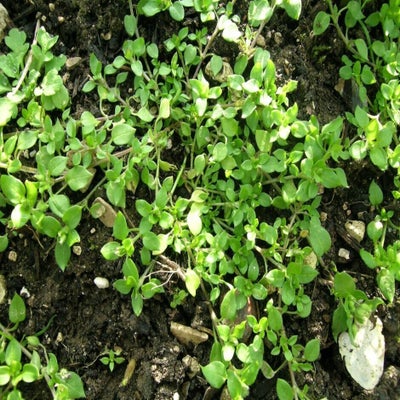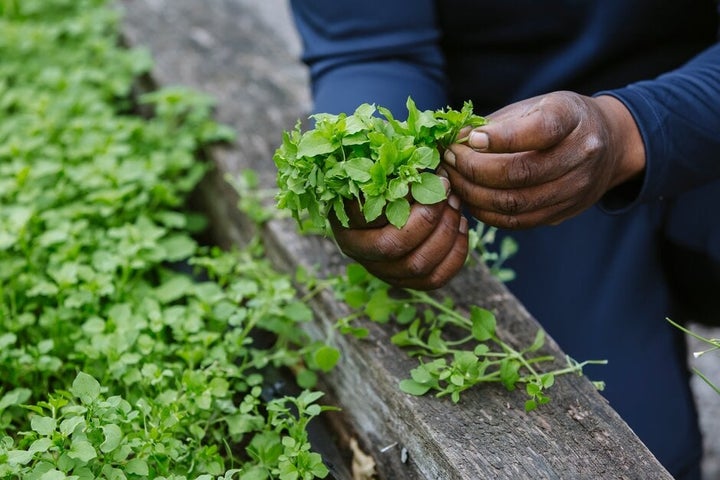
Quick facts
Chickweed’s botanical name is Stellaria media
Bees like the nectar-rich flowers and small birds eat the seed
Chickweed spreads quickly by seed and can become weedy in garden borders and veg patches
If you need to control chickweed, non-chemical methods are easy and effective
What does chickweed look like?
Chickweed is an annual , producing a clump of floppy stems around 35cm (14in) tall. The small, oval, pointed leaves are bright green and held opposite each other on the stem. In the evening, these fold together to protect the tender new growth. Underground, chickweed produces a mass of fine, shallow roots.
Tiny, white flowers with five divided petals arranged in a star shape are produced along the stems and in clusters at the tips throughout the year. Each flower only lasts a day or two before developing into a downward-hanging seedpod.

Did you know?
Chickweed gained its common name because it used to be widely fed to chickens. It is, however, also edible to humans, with the sweet, leafy spring growth making a good addition to salads and sandwiches.
Is chickweed a weed?
Chickweed is a that grows throughout the country, from farmland to coastland, as well as in gardens. However, as each plant produces many fast- seeds, chickweed can quickly form a carpet on bare soil – so is often considered a weed by gardeners.
Bear in mind that its flowers, produced throughout the year, provide nectar for bees, while the large quantity of seeds that follow are a welcome food source for chaffinches and other small birds. Left to grow in less conspicuous parts of the garden, chickweed is a valuable wildlife plant and an addition to your garden’s .
As it is edible, some gardeners even purposefully grow it as a leafy vegetable.


What is a weed?
The term ‘weed’ describes a plant that is growing where it isn’t wanted. Weeds usually thrive in average garden conditions, reproducing and spreading easily. It is up to you to decide what you call a weed and what you choose to retain or remove.
Frequently asked questions about controlling chickweed
Here are our answers to your most common questions about dealing with chickweed:
How invasive is chickweed?
Individual plants are small, shallow-rooted and easily removed, so there’s no need to panic if you find chickweed in your garden. By keeping a regular check on any chickweed plants you decide to leave, you can make sure they aren’t spreading out of bounds or becoming competition for your other plants.
However, do bear in mind that chickweed seeds spread easily on muddy boots and in topsoil and garden compost, so pay attention to good garden hygiene, and avoid moving soil from a patch where you have allowed chickweed to grow.
Do I need to get rid of chickweed?
No – allowing chickweed to grow in some areas, such as in a wildlife corner, at the back of borders or under mature plants, is a great way to attract wildlife and increase the of your garden. Leaving a small carpet of chickweed also helps to prevent soil erosion over winter, so is preferable to having bare soil.
It is, however, a good idea to control the spread of chickweed, particularly around and young plants which could become smothered or suffer from competition with the weed.
What is the easiest way to kill chickweed?
If you have chickweed growing where it is not wanted, there are a few easy ways to remove it:
- Pull or fork out plants – being shallow-rooted, chickweed is easily pulled out of the soil. Do this regularly to remove plants before they have chance to flower and set seed. Plants that are not yet in flower can be safely added to your own compost bin but, as the seeds can survive the home process, it is best to add any that are in flower to your council green waste recycling bin instead.
- Hoe off plants – carefully hoe beds and borders to remove chickweed before it sets seed. Do this on a dry, sunny day, so any uprooted plants shrivel and die rather than re-rooting. removes weeds with minimal soil disturbance.
- Smother plants – apply a mulch to your soil in early spring to smother new seedlings and prevent chickweed seeds . Use bulky organic matter, such as chips, and apply a thick layer around 8cm (3in) deep for best effect. Alternatively, fill gaps in borders with mat-forming ground cover plants. These will hide and out-compete chickweed seedlings as well as provide food and shelter for ground-active invertebrates.
Top Tip
Buried chickweed seeds can remain viable (alive) in the soil for a long time, so try to avoid digging over the ground in areas where you have a problem with this weed.
Should I use weedkiller?
As chickweed is easy to control by hoeing and pulling out, there’s no need to use a weedkiller.
For more information, see our page on Weeds: non-chemical controls.










